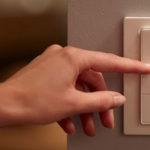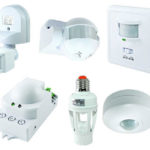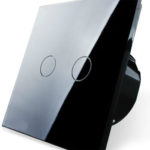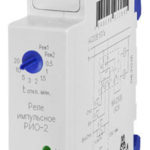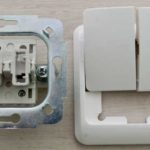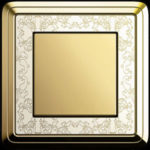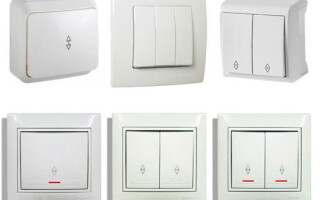Each owner of an apartment or house wants to spend time as comfortably as possible in his home and make his stay in the room carefree and convenient. A large number of different lighting fixtures in combination with a large living area can lead to the inconvenience of switching on and off the light when moving from one room to another. Pass-through switches were invented to help in solving this problem and to simplify life.
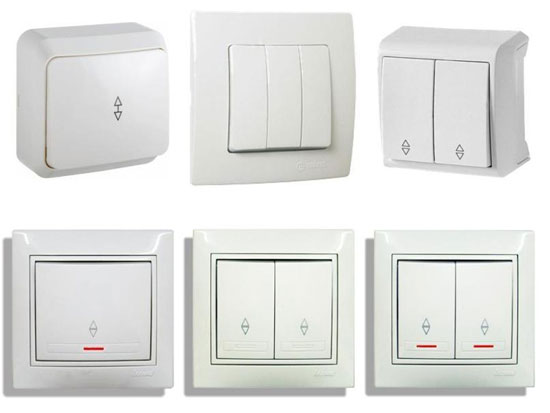
Content
Why are pass switches needed?
Through switches - a solution that has been successfully used for a long time and with success in lighting. With their help, you can turn on and off the same lighting device from several points in the room. Thanks to this, for example, a person who enters a corridor can turn on the light at the beginning and turn it off when he leaves it in another part of this room.
There are other ways to simplify the control of light in different parts of the room (sensors, sensors), but the advantage of feed-through switches is ease of installation, reliable operation under any conditions and the relative cheapness of this solution.
Such methods are widely used both in country houses and in residential premises of apartment buildings. Depending on the habits and needs of the inhabitants of the premises, walk-through switches can be mounted in corridors, at the entrance to rooms, at beds or resting places, and in other places as desired.
The principle of operation and the differences between walk-through switches from conventional ones
Working principle of standard wall switches lighting is based on the break or connection of the supply phase.
Note! According to the rules of the PUE, it is the phase that must be broken in the switch, and not zero.
This is important for the safe operation of lighting devices and the absence of voltage on them when turned off with a switch. A conventional switch has two contacts: one for connecting the supply phase and the other for connecting a lighting device. The switch has two positions: on and off.
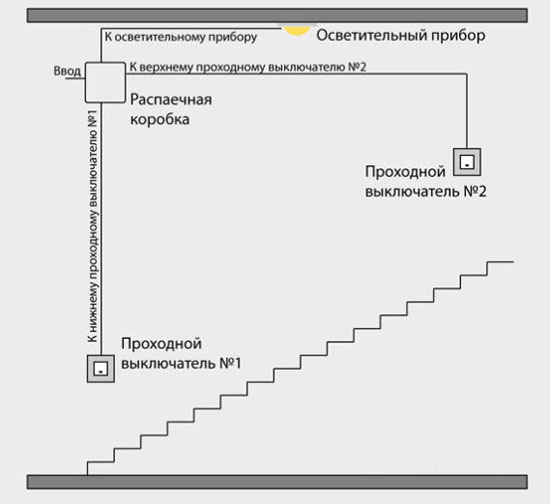
The pass switch has the same size and appearance (for any interior and color schemes), but structurally it is somewhat different from the usual one: it does not have an “off” position and has 3 contacts for connecting outgoing conductors. Such a device is mounted in pairs with another switch of the same type. In the pass-through switch, the circuit does not break, but the phase is switched from one contact to another.
Schematic electrical circuits for lighting control
Let's consider the schemes for installing switches for one device at different points in the room, as well as controlling several groups of lighting devices from several places.
Lighting control scheme from two places: two pass-through switches
To turn on lighting fixtures from two places, a system of two single-gang switches and conductors of the required length is assembled. A neutral wire is connected to the lighting device. And a phase is connected to the first switch, to its input contact. The two output contacts of the first switch are connected to the two outputs of the second switch. And from the input of the second switch, the phase is pulled to the lighting fixture.
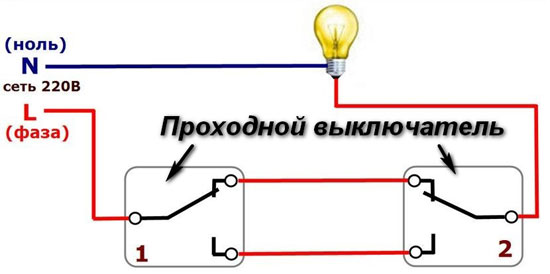
For example, we have two switches. Let's conditionally call them On1 and On2. Each of them has three contacts: No. 1, No. 2, No. 3 and No. 1 ', No. 2 ', No. 3 'respectively. Then, a phase wire is connected to contact No. 1 'On2, and a wire from the lighting device is connected to contact No. 1 On1. Contacts #2 and #2' are connected to each other, the same is done with contacts #3 and #3'. This is precisely the principle of transferring the phase from one contact to another, and, consequently, the possibility of operation of feed-through switches.
This scheme is presented to turn on the light from two places. Schemes for systems of three, four or more places look more complicated, but the principle of operation remains the same.
Lighting control scheme from three or more places: use of cross switches
The method of switching on light bulbs from three or more places differs in that a special cross switch is added to the circuit. Structurally, such a device has two contacts at the input and two contacts at the output, which allows it to switch contacts. It can be located at any convenient point in the room between two single pass-through switches. The phase is connected to the input contact of the first through switch, its two outputs are connected to the outputs of the cross switch. From the two remaining outputs of the switch, the wires are pulled to the outputs of the second switch, and a lighting device is connected from its input (to which the neutral conductor is already connected). It sounds complicated, but it's actually quite simple.
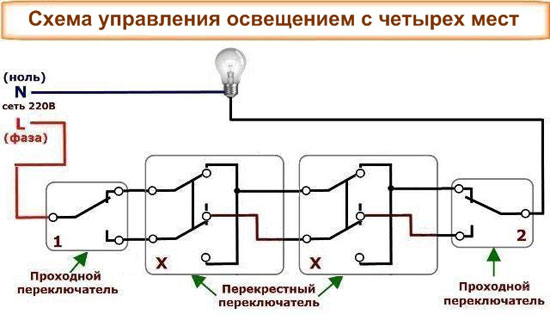
Independent control of two or more bulbs: wiring diagrams for two and three-gang switches
Sometimes it becomes necessary to control several lamps from different points in the room. To do this, it does not make sense to install separate walk-through switches for each lamp, because you can use two-key or three-key options. Two-button walk-through switches have two inputs and four outputs in their design, three-button switches have three inputs and six outputs.
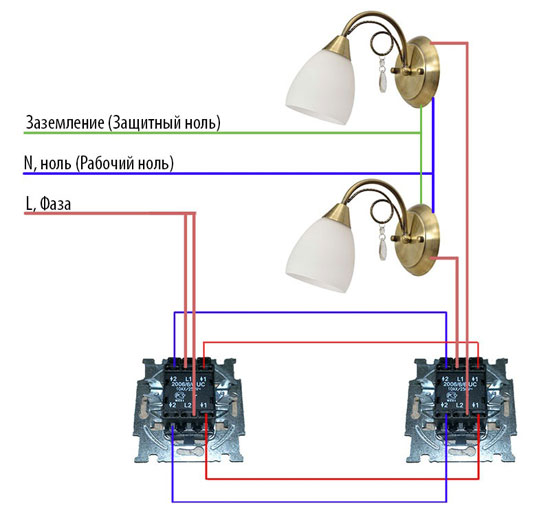
According to the plan for the location of lighting fixtures, wiring, junction boxes are installed and points are prepared (socket boxes) to install switches. The connection is similar to the walk-through switches for one lighting fixture.At the same time, due to the complexity of the device of such a system and a large number of conductors, it is best to make a connection based on a pre-drawn diagram and a layout plan for lighting fixtures.
If it is required to turn on two groups of lighting fixtures from three points, then use two two-button walk-through switches and one double cross switch. Such a switch has eight contact groups: four are used for one lighting fixture and four for another.
Mounting Recommendations
Pass-through switches are a convenient way to control light in spacious living spaces. But despite the fact that the scheme for connecting them is quite easy, nevertheless, certain knowledge and skills in electrical engineering will definitely not be superfluous during installation.
The most difficult process that the installer faces is the installation of hidden wiring to future mounting points for switches and lighting fixtures from junction boxes. For this type of work, you need the skill of wall chasing and a special tool (wall chaser with diamond discs, puncher, industrial vacuum cleaner). Completing installation work electric cable, be sure to test all lines for breaks and correct connection, and for this you need a multimeter with a continuity. But any switches, including walk-throughs, are finally mounted only after the completion of all fine finishing work.
When choosing walk-through switches, it is best to focus on eminent foreign manufacturers of electrical products: Legrand, ABB, Sneider Electric. But if the budget is limited, then domestic options can be purchased.
And most importantly, remember: electricity is life-threatening, do all work only when the power is off and in compliance with electrical safety rules!
Similar articles:
